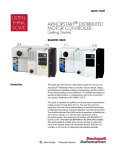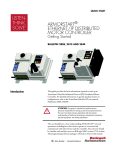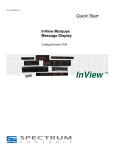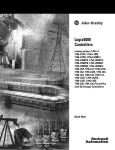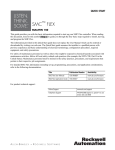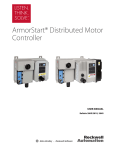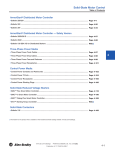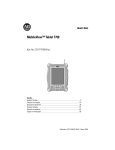Download armorstart distributed motor controller
Transcript
QUICK START ARMORSTART® DISTRIBUTED MOTOR CONTROLLER Getting Started BULLETIN 280D/281D Introduction This guide provides the basic information required to start up your ArmorStart® Distributed Motor Controller. Factory default settings and information regarding installing, programming, and DeviceNet™ Node Commissioning are described here. For detailed information on specific product features or configurations, refer to the ArmorStart user manual, publication 280-UM001*-EN-P. This guide is intended for qualified service personnel responsible for setting up and servicing these devices. You must have previous experience with and a basic understanding of electrical terminology, configuration procedures, required equipment, and safety precautions. You should understand DeviceNet network operations, including how slave devices operate on a network and communicate with a DeviceNet master. You should also be familiar with RSNetWorx™ for DeviceNet. You must use RSNetWorx for DeviceNet Revision 3.21 Service Pack 2 or later. This software package is referred to often in this manual. Rockwell Automation product EDS files are available on the internet at: http://www.ab.com/networks/eds. 2 Installation The ArmorStart Distributed Motor Controller is convection cooled. Operating temperature must be kept between -20…40°C (-4…104°F). Dimensions Dimensions are shown in millimeters (inches). Dimensions are not intended to be used for manufacturing purposes. All dimensions are subject to change. Figure 1 Dimensions for IP67/NEMA Type 4 with Conduit Entrance Publication 280D-QS001D-EN-P - July 2006 3 Dimensions are shown in millimeters (inches). Dimensions are not intended to be used for manufacturing purposes. All dimensions are subject to change. Figure 2 Dimensions for IP67/NEMA Type 4 with ArmorConnect™ Connectivity ArmorStart device with a 10 A short circuit protection rating ArmorStart device with a 25 A short circuit protection rating Publication 280D-QS001D-EN-P - July 2006 4 Dimensions are shown in millimeters (inches). Dimensions are not intended to be used for manufacturing purposes. All dimensions are subject to change. Figure 3 Dimensions for NEMA Type 4X with Conduit Entrance Publication 280D-QS001D-EN-P - July 2006 5 Dimensions are shown in millimeters (inches). Dimensions are not intended to be used for manufacturing purposes. All dimensions are subject to change. Figure 4 Dimensions for NEMA Type 4X with ArmorConnect Connectivity ArmorStart device with a 10 A short circuit protection rating ArmorStart device with a 25 A short circuit protection rating Publication 280D-QS001D-EN-P - July 2006 6 Wiring Power, Control, Safety Monitor Inputs, and Ground Wiring Table 1 provides the power, control, safety monitor inputs, ground wire capacity and the tightening torque requirements. The power, control, ground, and safety monitor terminals will accept a maximum of two wires per terminal. Table 1 Terminal Designations for Conduit Entrance Power, Control, Safety Monitor Inputs, Ground Wire Size, and Torque Specifications Terminals Wire Size Torque Wire Strip Length Power and Ground Primary/Secondary Terminal: 1.0…4.0 mm2 (#18 …#10 AWG) Primary Terminal: 10.6…21.6 lb.-in. (1.2…2.4 N•m) Secondary Terminal: 5.3…7.3 lb.-in (0.6…0.8 N•m) 0.35 in. (9 mm) Control and Safety Monitor Inputs 0.34mm2…4.0 mm2 (#22…#10 AWG) 5.0…5.6 lb.-in (0.6 N•m) 0.35 in. (9 mm) As shown in Figure 5, the ArmorStart Distributed Motor Controller contains terminals for power, control, safety monitor inputs, and ground wiring. Access can be gained by removing the terminal access cover plate. Figure 5 ArmorStart Power, Control, and Safety Monitor Terminals Secondaries Primaries Publication 280D-QS001D-EN-P - July 2006 7 Table 2 Power, Control, Safety Monitor, and Ground Terminal Designations Terminal Designations No. of Poles Description SM1 ➊ SM2 ➊ A1 (+) A2 (-) PE 1/L1 3/L3 5/L5 2 2 2 2 2 2 2 2 Safety Monitor Input Safety Monitor Input Control Power Input Control Power Common Ground Line Power Phase A Line Power Phase B Line Power Phase C ➊ Only available with the Safety Monitor option. Operation of NEMA Type 4X Disconnect Handle To Open Disconnect Handle 1. Rotate locking ring 45° until it stops. 2. To open, push the tab on the left-hand side and lift the access cover. Note: The access door can not be closed when 140 (black handle) is in the OFF position. To Close Disconnect Handle for Lockout/Tag out With disconnect handle in the ON position, rotate lockout/tag out ring counterclockwise until the disconnect handle is in the OFF position. Note: The disconnect hanlde is designed to be used with a 1/4 in. lockout/tag out padlock. Publication 280D-QS001D-EN-P - July 2006 8 ArmorConnect Power Media Description The ArmorStart Power Media offers both three-phase and control power cable system of cordsets, patchcords, receptacles, tees, reducers and accessories to be utilized with the ArmorStart Distributed Motor Controller. These cable system components allow quick connection of ArmorStart Distributed Motor Controllers and reduce installation time. They provide for repeatable, reliable connection of the three-phase and control power to the ArmorStart Distributed Motor Controller and motor by providing a plug and play environment that also avoids system mis-wiring. When specifying power media for use with the ArmorStart Distributed Motor Controllers (Bulletins 280, 281, 283, and 284) use only Bulletin 280 ArmorConnect™ power media. Figure 6 Three-Phase Power System Overview Enclosure PLC Bulletin 1492FB Branch Circuit Protective Device Bulletin 1606 Power Supply 1606-XLSDNET4 DeviceNet Power Supply Bulletin 284 ArmorStart Bulletin 283 ArmorStart Bulletin 280/281 ArmorStart RESET OFF Bulletin 800F Emergency Stop Pushbutton ➊ Three-Phase Power Trunk- PatchCord cable with integral female or male connector on each end Example Part Number: 280-PWR35A-M* ➋ Three-Phase Drop Cable- PatchCord cable with integral female or male connector on each end Example Part Number: 280-PWR22A-M* ➌ Three-Phase Power Tees and Reducer Tee connects to a single drop line to trunk with quick change connectors – Part Number: 280-T35 Reducing Tee connects to a single drop line (Mini) to trunk (Quick change) connector – Part Number: 280-RT35 Reducer connects from quick change male connector to mini female connector– Part Number: 280-RA35 ➍ Three-Phase Power Receptacles Female receptacles are a panel mount connector with flying leads – Part Number: 280-M35F-M1 Publication 280D-QS001D-EN-P - July 2006 9 Figure 7 Control Power Media System Overview Enclosure PLC Bulletin 1492FB Branch Circuit Protective Device Bulletin 1606 Power Supply 1606-XLSDNET4 DeviceNet Power Supply Bulletin 284 ArmorStart Bulletin 283 ArmorStart Bulletin 280/281 ArmorStart RESET OFF Bulletin 800F Emergency Stop Pushbutton ➏ Control Power Media Patchcords - PatchCord cable with integral female or male connector on each end Example Part Number: 889N-F65GFNM-* ➐ Control Power Tees - The E-stop In Tee (Part Number: 898N-653ES-NKF) is used to connect to the Bulletin 800F On-Machine E-Stop station using a control power media patchcord. The E-stop Out tee (Part Number: 898N-653ST-NKF) is used with cordset or patchcord to connect to the ArmorStart Distributed Motor Controller. ➑ Control Power Receptacles - Female receptacles are a panel mount connector with flying leads – Part Number: 888N-D65AF1-* Publication 280D-QS001D-EN-P - July 2006 10 ArmorStart with ArmorConnect Connectivity ArmorStart devices with 25 A short circuit protection rating ArmorStart devices with 10 A short circuit protection rating Control Power Receptacle Three-Phase Power Receptacle Control Power Receptacle Three-Phase Power Receptacle Installing ArmorConnect Power Media using Cord Grips Cord Grips for ArmorStart Devices with 10 A short circuit protection rating 3/4 in. Lock Nut Thomas & Betts Cord Grip Part Number: 2931NM 3/4 in. Stain Relief Cord Connector Cable Range: 0.31…0.56 in. Used with Control Power Media Cordset - Example Part Number: 889N-M65GF-M2 1 in. Lock Nut Thomas & Betts Cord Grip Part Number: 2940NM 1 in. Stain Relief Cord Connector Cable Range: 0.31…0.56 in. Used with Three-Phase Power Media Cordset - Example Part Number: 280-PWR22G-M1 Cord Grips for ArmorStart Devices with 25 A short circuit protection rating 3/4 in. Lock Nut Thomas & Betts Cord Grip Part Number: 2931NM 3/4 in. Stain Relief Cord Connector Cable Range: 0.31…0.56 in. Used with Control Power Media Cordset - Example Part Number: 889N-M65GF-M2 Publication 280D-QS001D-EN-P - July 2006 1 in. Lock Nut Thomas & Betts Cord Grip Part Number: 2942NM 1 in. Stain Relief Cord Connector Cable Range: 0.70…0.95 in. Used with Three-Phase Power Media Cordset - Example Part Number: 280-PWR35G-M1 11 Terminal Designations Description Color Code A1 (+) Control Power Input Blue A2 (-) Control Power Common Black PE Ground Green/Yellow 1/L1 Line Power - Phase A Black 2/L2 Line Power - Phase B White 3/L3 Line Power - Phase C Red ArmorConnect Cable Ratings The ArmorConnect Power Media cables are rated per UL Type TC 600V 90 °C Dry 75 °C Wet, Exposed Run (ER) or MTW 600V 90 °C or STOOW 105 °C 600V - CSA STOOW 600V FT2. For additional information regarding ArmorConnect Power Media see the ArmorStart User Manual. Branch Circuit Protection Requirements for ArmorConnect™ Three-Phase Power Media When using ArmorConnect Three-Phase Power Media, only fuses can be used for the motor branch circuit protective device, for the group motor installations. The recommended fuse types are the folowing: Class CC, T, or J type fuses. For additional information, see the ArmorStart User Manual. Publication 280D-QS001D-EN-P - July 2006 12 Group Motor Installations for USA and Canada Markets The ArmorStart Distributed Motor controllers are listed for use with each other in group installations per NFPA 79, Electrical Standard for Industrial Machinery. When applied according to the group motor installation requirements, two or more motors, of any rating or controller type, are permitted on a single branch circuit. Group Motor Installation has been successfully used for many years in the USA and Canada. Wiring and Workmanship Guidelines In addition to conduit and seal-tite raceway, it is acceptable to utilize cable that is dual rated Tray Cable, Type TC-ER and Cord, STOOW, for power and control wiring on ArmorStart installations. In the USA and Canada installations, the following guidance is outlined by the NEC and NFPA 79. In industrial establishments where the conditions of maintenance and supervision ensure that only qualified persons service the installation, and where the exposed cable is continuously supported and protected against physical damage using mechanical protection, such as struts, angles, or channels, Type TC tray cable that complies with the crush and impact requirements of Type MC (Metal Clad) cable and is identified for such use with the marking Type TC-ER (Exposed Run)* shall be permitted between a cable tray and the utilization equipment or device as open wiring. The cable shall be secured at intervals not exceeding 1.8 m (6 ft) and installed in a “good workman-like” manner. Equipment grounding for the utilization equipment shall be provided by an equipment grounding conductor within the cable. *Historically cable meeting these crush and impact requirements were designated and marked “Open Wiring”. Cable so marked is equivalent to the present Type TC-ER and can be used. While the ArmorStart is intended for installation in factory floor environments of industrial establishments, the following must be taken into consideration when locating the ArmorStart in the application: Cables, including those for control voltage including 24V DC and communications, are not to be exposed to an operator or building traffic on a continuous basis. Location of the ArmorStart to minimize exposure to continual traffic is recommended. If location to minimize traffic flow is unavoidable, other barriers to minimize inadvertent exposure to the cabling should be considered. Routing cables should be done in such a manner to minimize inadvertent exposure and/or damage. Additionally, if conduit or other raceways are not used, it is recommended that strain relief fittings be utilized when installing the cables for the control and power wiring through the conduit openings. The working space around the ArmorStart may be minimized as the ArmorStart does not require examination, adjustment, servicing or Publication 280D-QS001D-EN-P - July 2006 13 maintenance while energized. In lieu of this service, the ArmorStart is meant to be unplugged and replaced after proper lockout/tag-out procedures have been employed. Since the ArmorStart is available with a factory installed HOA keypad option this may require the ArmorStart to be selected and installed as follows if the application requires frequent use of the hand operated interface by the equipment operator: 1. They are not less than 0.6 m (2 ft) above the servicing level and are within easy reach of the normal working position of the operator. 2. The operator is not placed in a hazardous situation when operating them. 3. The possibility of inadvertent operation is minimized. If the operated interface is used in industrial establishments where the conditions of maintenance and supervision ensure that only qualified persons operate and service the ArmorStart's operator interface, and the installation is located so that inadvertent operation is minimized then other installation locations with acceptable access can be provided. DeviceNet Network Installation The ArmorStart Distributed Motor Controller contains the equivalent of 30 in. (0.76 m) of DeviceNet drop cable's electrical characteristics and therefore 30 in. of drop cable must be included in the DeviceNet drop cable budget for each ArmorStart in addition to actual drop cable required for the installation. Other DeviceNet System Design Considerations The separation of the control power and DeviceNet power is recommended as a good design practice. This minimizes the load on the DeviceNet supply, and prevents transients which may be present on the control power system from influencing the communication controls. Publication 280D-QS001D-EN-P - July 2006 14 LED Status Indication The LED Status Indication provides 4 status LEDs and a Reset button. The LEDs provide status indication for the following: • POWER LED The LED is illuminated solid green when control power is present and with the proper polarity • RUN LED This LED is illuminated solid green when a start command and control power are present • NETWORK LED This bi-color (red/green) LED indicates the status of the communication link • FAULT LED Indicates Controller Fault (trip) condition The “Reset Button” as a local trip reset. Figure 8 LED Status Indication and Reset DeviceNet Node Commissioning Establishing a DeviceNet Node Address The ArmorStart is shipped with a default node address of 63 and Autobaud enabled. Each device on a DeviceNet network must have a unique node address or MAC ID which can be set to a value from 0…63. Keep in mind that most DeviceNet systems use address 0 for the master device (Scanner) and node address 63 should be left vacant for introduction of new slave devices. The ArmorStart offers two methods for node commissioning as shown in the following pages. Node Commissioning using Software To set the node address of the ArmorStart using software or other handheld tools, leave the hardware rotary switches in their default position (99) or insure that they are set to something greater then (63). With the hardware switches set, use the software or handheld tool to change the address. When using software to node commission a device, it may be necessary to have the EDS file stored on the computer. The EDS file defines how the software such as RSNetWorx for DeviceNet will communicate to the ArmorStart. Rockwell Automation product EDS files are available on the internet at: http://www.ab.com/networks/eds. You must use RSNetWorx for DeviceNet Revision 3.21 Service Pack 2 or later. Publication 280D-QS001D-EN-P - July 2006 15 Node Commissioning using Hardware The ArmorStart is shipped with the hardware rotary switches set to a value of (99). If the switches are set to a value of (64) or above, the device will automatically configure itself to the software node address. If the switches are set to a value of (63) or less, the device will be at the node address designated by the switch configuration. To set an address using the hardware rotary switches, simply set the switches to the desired node address. To access the node address rotary switches, three-phase and control power should be turned off. Then remove the starter module from the base unit. The rotary node address switches are located on the back side of the starter module. Change the switches to the desired node address. Re-install the starter module to the base unit. Reapply power and the device will re-start at the new address. Figure 9 Rotary Node Address Configuration See Detail A MSD LSD Detail A System Configuration Information The following information is provided to identify the default method for setting up communication to the ArmorStart. Additional configuration information and advanced settings help can be found in the ArmorStart User Manual, Publication 280-UM001*-EN-P. Using Automap feature with default Input and Output (I/O) assemblies The Automap feature available in all Rockwell Automation scanners will automatically map the information as shown below. If manual mapping is Publication 280D-QS001D-EN-P - July 2006 16 required, the information below can be used to map a device based on the default configuration. Table 3 Default I/O Messaging Data Default Message type Polled Consumed data size 1 byte (Rx) Produced data size 2 bytes (Tx) Default Input and Output (I/O) Assembly Formats The I/O assembly formats for the ArmorStart are identified by the value in parameter 11 (Consumed IO Assy.) and parameter 12 (Produced IO Assy.). These values determine the amount and arrangement of the information communicated to the master scanner. The tables below identify the default information produced and consumed by DOL (Bulletin 280) and Reversing (Bulletin 281) devices. For additional formats and advance configurations please reference the user manual: Defaults for Standard Distributed Motor Controllers Table 4 Instance 160 - Default Consumed data for Standard Distributed Motor Controller Output information arrangement (1 byte) Byte Bit 7 Bit 6 Bit 5 Bit 4 Bit 3 Bit 2 0 User Out B User Out A Not Used Not Used Not Used Fault Reset Table 5 Bit 1 Bit 0 Run Rev Run Fwd Instance 161 - Default Produced data for Standard Distributed Motor Controller Input information arrangement (2 bytes) Byte Bit 7 Bit 6 Bit 5 Bit 4 Bit 3 Bit 2 Bit 1 Bit 0 0 Not Used Not Used Not Used Ready Running Rev Running Fwd Warning Tripped 1 Not Used Not Used 140M On HOA Status User In 3 User In 2 User In 1 User In 0 Setting the Motor FLA and Overload Trip Class The product should now be configured and communicating on the network. The last step is to program the proper motor FLA setting (parameter #106) and overload trip class (parameter #107). This can be accomplished by using software such as RSNetWorx for DeviceNet or a handheld DeviceNet tool. Publication 280D-QS001D-EN-P - July 2006 17 Use the software to access the device parameters screen. By default the motor FLA is set to the minimum FLA setting for the device and the overload trip class is set to 10. Set these parameters to the desired values and download to the device. Select FLA setting (parameter #106) and enter a value that corresponds to the FLA of the motor connected to the ArmorStart. Make sure the Single radio button is selected and then select Download to Device. Select Overload Class (parameter #107) and choose the overload trip class to be used with the motor connected to the ArmorStart. The ArmorStart can be set up for trip class 10, 15, or 20. Make sure the Single radio button is selected and then select Download to Device. The proper motor protection is now in place. Figure 10 RSNetWorx Parameter Screen Publication 280D-QS001D-EN-P - July 2006 18 Quick Reference Troubleshooting There are four LEDs on the front of the ArmorStart that can provide an indication as to the health of the device. The following is a brief explanation of the operation of each LED. Table 6 LED Status Indication LED Power This LED will be illuminated solid green when control power is present and with the proper polarity. Run This LED will be illuminated solid green when a start command and control power is present. Network This bi-color LED is used to indicate the status of the DeviceNet network. See the Network Status LED table below for additional information. Fault This LED is used to indicate the fault status of the ArmorStart. When the unit is faulted, the unit will respond with a specific blink pattern to identify the fault. See the Fault LED table below for additional information. Table 7 Network Status LED Definition Network LED Status Indication Definition Possible Causes Off The device has not completed the initialization, is not on an active network, or may not be powered up. Check to make sure the product is properly wired and configured on the network. Flashes green-red-off While waiting to detect the network baud rate, the LED will flash this pattern about every 3 seconds. If the product stays in this state it means that there is no set baud rate. Insure that at least one device on the network has a set baud rate. Solid Green The device is operating in a normal condition, and is communicating to another device on the network. No action required. Flashing Green The device is operating in a normal condition, is on-line, but with no connection to another device. This is the typical state for new devices. The device may need to be mapped to a master scanner, placed in a scanlist, or have another device communicate to it. Flashing Red Recoverable fault has occurred. Check to make sure the PLC and scanner are operating correctly and that there are no media/cabling issues. Check to see if other networked devices are in a similar state. Solid Red The device has detected a major error that has rendered it incapable of communicating on the network (Duplicate MAC ID, Bus-off, media issue). Troubleshooting should be done to ensure that the network is correct (terminators, lengths, etc.) and there is not a duplicate node problem. If other devices on the network appear to be operating fine and power cycling the device does not work, contact Technical Support. Flashing Red and Green The device is in a communication faulted state. Power cycling the device may resolve the problem; however, if the problem continues, it may be necessary to contact Technical Support. Publication 280D-QS001D-EN-P - July 2006 19 Fault LED indications for Bulletin 280D and 281D ArmorStart Distributed Motor Controllers Blink Pattern Table 8 Definitions Controller Fault LED Definitions Possible Causes or Remedies Short Circuit The motor circuit protector has tripped, or the internal wiring protection algorithm has detected an unsafe current range. Try to reset the protector if tripped. If the condition continues, check the power wiring. This fault cannot be disabled. Overload trip The load has drawn excessive current and based on the trip class selected, the device has tripped. Verify that the load is operating correctly and the ArmorStart is properly set-up. This fault cannot be disabled. Phase Loss The ArmorStart has detected a missing phase. Verify that three-phase voltage is present at the line side connections. This fault can be disabled and is disabled by default. 4 Reserved Not Used 5 Reserved Not Used Control Power The ArmorStart has detected a loss of the control power voltage. Check control voltage, wiring, and proper polarity. Also, check and replace the control voltage fuse ,if necessary. This fault can be disabled and is disabled by default. I/O Fault This error indicates a shorted sensor, shorted input device, wiring input mistakes, or a blown output fuse. If this fault occurs, the offending problem should be isolated or removed prior to restarting the system. This fault can be disabled and is disabled by default. Over Temperature This fault is generated when the operating temperature has been exceeded. This fault cannot be disabled. Phase Imbalance The ArmorStart has detected a voltage imbalance. Check the power system and correct if necessary. This fault can be disabled and is disabled by default. DNet Power Loss DeviceNet power has been lost or has dropped below the 12V threshold. Check the state of the network power supply and look for DeviceNet media problems. This fault can be disabled and is disabled by default. 11 Reserved Not Used 12 Reserved Not Used EEPROM Fault This is a major fault, which renders the ArmorStart inoperable. Possible causes of this fault are transients induced during EEprom storage routines. If the fault was, initiated by a transient, power cycling should clear the problem otherwise replacement of the ArmorStart may be required. This fault cannot be disabled. Hardware Fault This fault indicates that a serious hardware problem exists. Check for a base/starter module mismatch. If no mismatch exists, the Armor Start may need to be replaced. (Hdw Flt is the factory-enabled default setting.) This fault cannot be disabled. 1 2 3 6 7 8 9 10 13 14 Publication 280D-QS001D-EN-P - July 2006 20 Bulletin 280/281 Parameters Table 9 Parameter Name String Starter Display and Parameter Settings Path (hex) Min Max Dflt Type Value Starter Display 101 Phase A Current 002C – 01 – 08 0 32767 — INT xxx.x Amps 102 Phase B Current 002C – 01 – 09 0 32767 — INT xxx.x Amps 103 Phase C Current 002C – 01 – 0A 0 32767 — INT xxx.x Amps 104 Average Current 002C – 01 – 05 0 32767 — INT xxx.x Amps 105 % Therm Utilized 002C – 01 – 07 0 100 — USINT xxx % Min I INT xxx.x Amps Starter Settings 106 FLA Setting 002C – 01 – 03 See Table 10 below 107 OL Trip Class 002C – 01 – 04 0 3 1 BYTE 1 = 10 2 = 15 3 = 20 108 OL Reset Level 0029 – 01 – 131 0 100 75 BYTE xxx % Table 10 FLA Setting Ranges and Default Values (with indicated setting precision) FLA Current Range (A) Default Value Publication 280D-QS001D-EN-P - July 2006 Minimum Value Maximum Value 0.24 1.2 0.24 0.5 2.5 0.5 1.1 5.5 1.1 3.2 16.0 3.2 21 Figure 11 Bulletin 280/281 ArmorStart Local Disconnect LED Status Indication 2 Outputs (Micro/M12) 4 Inputs (Micro/M12) Motor Connection DeviceNet Connection (Mini/M18) Ground Terminal Figure 12 Bulletin 280/281 ArmorStart with ArmorConnect Control Power Three-Phase Power Ground Terminal Control Power Three-Phase Power Ground Terminal Publication 280D-QS001D-EN-P - July 2006 22 Table 11 DeviceNet Media ➊ Description Length m (ft) Cat. No. Sealed KwikLink pigtail drops are Insulation Displacement Connector (IDC) with integral Class 1 round cables for interfacing devices or power supplies to flat cable Thick Cable 1485P-P1E4-B1-N5 1485P-P1E4-B2-N5 3 m (9.8) 1485P-P1E4-B3-N5 6 m (19.8) 1485P-P1E4-B6-N5 Right Keyway Left Keyway 1485P-P1N5-MN5NF 1485P-P1N5-MN5KM Connector Cat. No. Mini Straight Female Mini Straight Male 1485G-P➋N5-M5 Mini Straight Female Mini Right Angle Male 1485G-P➋W5-N5 Mini Right Angle Female Mini Straight Male 1485G-P➋M5-Z5 Mini Right Angle Female Mini Straight Male 1485G-P➋W5-Z5 Mini Straight Female Mini Straight Male 1485C-P➌N5-M5 Mini Straight Female Mini Right Angle Male 1485C-P➌W5-N5 Mini Right Angle Female Mini Straight Male 1485C-P➌M5-Z5 Mini Right Angle Female Mini Straight Male 1485C-P➌W5-Z5 DeviceNet Mini- T-Port Tap Gray PVC Thin Cable 1 m (3.3) 2 m (6.5) ➊ See publication M116-CA001A-EN-P for complete cable selection information. ➋ Replace symbol with desired length in meters (Example: 1485G-P1N5-M5 for a 1 m cable). Standard cable lengths: 1 m, 2 m, 3 m, 4 m, 5 m, and 6 m. ➌ Replace symbol with desired length in meters (Example: 1485C-P1N5-M5 for a 1 m cable). Standard cable lengths: 1 m, 2 m, 3 m, 4 m, 5 m, 6 m, 8 m, 10 m, 12 m, 18 m, 24 m, and 30 m. NOTE: Stainless steel versions may be ordered by adding an “S” to the cat. no. (Example: 1485CS-P1N5-M5) Publication 280D-QS001D-EN-P - July 2006 23 Table 12 Sensor Media ➊ Description ArmorStart I/O Connection Pin Count Connector Cat. No. Straight Female Straight Male 889D-F4ACDM-➋ Straight Female Right Angle Male 889D-F4AACDE-➋ Straight Female 879D-F4ACDM-➋ Right Angle Male 879D-R4ACM-➋ Straight Female Right Angle Male 879D-F4ACTE-➋ Straight Female Straight Male 889R-F3AERM-➋ Straight Female Right Angle Male 899R-F3AERE-➋ 0 Input 5-Pin 0 DC Micro Patchcord 0 Input 5-pin 0 DC Micro V-Cable 0 Input 5-pin 0 DC Micro Y-Cable Output 3-pin AC Micro Patchcord ➊ See Publication M116-CA001A-EN-P for complete cable selection information. ➋ Replace symbol with desired length in meters (Example: 889D-F4ACDM-1 for a 1 m cable). Standard cable lengths: 1 m, 2 m, 5 m, and 10 m. NOTE: Stainless steel versions may be ordered by adding an “S” to the cat. no. (889DS-F4ACDM-1) Table 13 Sealing Caps ➌ ➌ Description Used on I/O Connection Catalog Number Plastic Sealing Cap (M12) Input 1485A-M12 Aluminum Sealing Cap Output 889A-RMCAP To achieve IP67 rating, sealing caps must be installed on all unused I/O connections. Publication 280D-QS001D-EN-P - July 2006 Registered Trademark List ArmorPoint and ArmorStart are registered trademarks of Rockwell Automation, Inc. Trademark List ArmorConnect, RSLogix5000, PLC, RSNetWorx, and SLC are trademarks of Rockwell Automation, Inc. DeviceNet and the DeviceNet logo are trademarks of the Open Device Vendors Association (ODVA). Publication 280D-QS001D-EN-P — July 2006 Superecedes Publication 280D-QS001C-EN-P — September 2005 41053-384-01 (1) Copyright ©2006 Rockwell Automation, Inc. All Rights Reserved. Printed in USA.
























